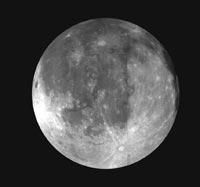On the moon and always in the sun

To reach this conclusion they have used a series
of photographs taken during a lunar day, 28 days on Earth.
Something similar happens at the poles of the Earth on summer days, the sun does not hide, but in winter the opposite happens: the sun does not appear. This phenomenon is because the Earth's axis of rotation is tilted about 23 degrees. On the contrary, the inclination of the Moon is only 1.5 degrees, so it is possible that in some polar areas it is always maintained during the day, as at the edges of the Peary crater of the North Pole.
The South Pole has not yet been studied, so it remains to be seen if there are areas of incessant sun.
However, the researchers have shown their satisfaction with the fact that they can be suitable spaces to locate the bases on the Moon, where it is estimated that there is a temperature of 50 °C below zero, warm atmosphere compared to the -180 °C of the lunar equator.





